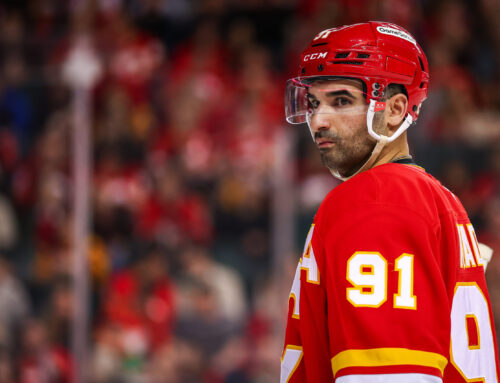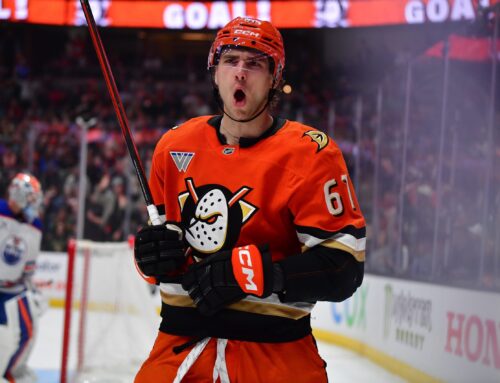
Top 10 players who spiked in shooting percentage (2017-18)
There are lots of factors to consider why a player all of a sudden saw a dramatic increase in goals from one season to the next: more power play time, more shots, better linemates or a trade to a new team.
Looking at players who saw a major spike in shooting percentage this year could save you some headaches next year. Remember, an extra uptick of five percentage points is an extra 10 goals during the course of the season, assuming the player takes 200 shots. And that’s just five percentage points. A couple of players on this list saw increases around nine per cent, while another was up 15.7 percentage points. That’s just insane.
You may notice players such as J.T. Miller, Mark Stone and Brad Marchand are missing from the list, but that is because high shooting percentages are the standard for those guys.
One thing to note is that you won’t see a lot of young players on this list, as there’s no real baseline for them. Mikko Rantanen, for example, has posted shooting percentages of 15 and 16.3 per cent in his first two full seasons. That could be the norm for him.
10. Dustin Brown
Brown had an excellent season, potting 28 goals on 12.6 per cent shooting. However, Brown averaged 6.6 per cent in his previous four seasons; his highest during that span coming in 2016-17 when he shot 8 per cent. One thing to keep in mind for next season is how Brown’s shooting percentage dropped in the second half. In his first 40 games, Brown shot 15.2 per cent, compared to 7.3 per cent in his next 38 games. Four goals in the second-last game of the season brought Brown’s second-half number to 10.6 per cent overall, but you should count more on the latter than the former for next season.
9. Eric Staal
Staal has been rejuvenated in Minnesota, scoring 70 goals in the last two years. In his last five seasons with Carolina (including 20 games with the Rangers), Staal averaged a 9.1 shooting percentage. In his first year with the Wild, Staal’s shooting percentage jumped to 13.3 per cent. This year was a career-high 17.4 per cent. Expect a small dip next year, but there’s no reason to believe he can’t continue with a shooting percentage into the teens.
RNH’s 24 goals and 48 points don’t look that impressive to start, but then you remember he only played 62 games because of cracked ribs. The Oilers centre had a career average shooting percentage of 10.7 going into the season, but hit 15.9 per cent this year. With his shot pace and shooting percentage, he would have hit 32 goals had he stayed healthy.
Couture set a career high of 34 goals this season, but don’t count on that happening again next year. While he had a four-year average of 11.2 per cent shooting percentage and a career average of 11.9 per cent going into this season, his 16.7 per cent in 2017-18 looks to be an outlier. Don’t forget his Band-Aid boy status means you can’t count on him for more than 75 games.
6. Phil Kessel
Kessel’s shooting percentage increase wasn’t as significant as many others on this list, but it does bear noting. He averaged 9.5 per cent over three seasons before this year, which then jumped to 13 per cent. Strangely enough, that increase helped Kessel reach his first 30-goal campaign since 2013-14. With rumours that Kessel could be on his way out in Pittsburgh, he won’t have the luxury of playing next to elite superstars anymore, and that shooting percentage could go back to average next year.
Karlsson is an interesting case as there’s no real baseline outside of third- and fourth-line minutes in Columbus. He had a career 7.7 shooting percentage going into this season, and then had a league-high 23.4 per cent. Could he hit 40 again next year? That will be tough, but look at it this way. He only took 184 shots this year. If he takes 230 shots next year, and shoots 16 per cent, that equals 37 goals. That shooting percentage is still high, but it is still seven percentage points lower than what he got this year.
Giroux is coming off an excellent fantasy season, where he put up career highs in goals, assists, points and plus-minus. All that was capped off by a career-high 17.6 per cent shooting percentage. How crazy high was that? His three-year average before this past season was 8.5 per cent. If he had put up that mark this year, he would have scored 16 goals instead of 34.
3. Anze Kopitar
Kopitar’s shooting percentage of 17.5 per cent this year isn’t that high compared to his 14.1 per cent in 2015-16, but it’s still his highest of all time, and more than double than his eight per cent from a year ago. One thing to worry about Kopitar is his shot total isn’t that high. His 200 shots this year is the highest of the past five years. Let’s look at his five-year averages of 172 shots and a shooting percentage of 13.6 per cent. That’s 23 goals, a dozen less than the 35 he posted this year.
2. Taylor Hall
Hall’s career season was completely unexpected, especially in the goals category where he had 39, smashing his career high of 27 goals. He had a career-high shooting percentage and a career-high shots-per-game total. His career average shooting percentage coming into this season was 10.3 per cent, and his three-year average was 8.8 per cent. This year he topped out at 14 per cent.
What’s a little insane about MacKinnon’s shooting percentage is how average it has been. He shot 10 per cent as a rookie, but that was the only time he ever hit double digits before this year. His career average before this season was 8.1 per cent, and It was as low as 6.4 per cent in 2016-17. This year, it jumped to 13.7 per cent, which is actually pretty average for elite players. He’s one of a few on this list you would bet on repeating his shooting percentage next season.
Follow Tom on Twitter @DH_newfcollins





 CHI
CHI N.J
N.J MTL
MTL CBJ
CBJ BOS
BOS PIT
PIT DET
DET L.A
L.A ANA
ANA COL
COL NYR
NYR
